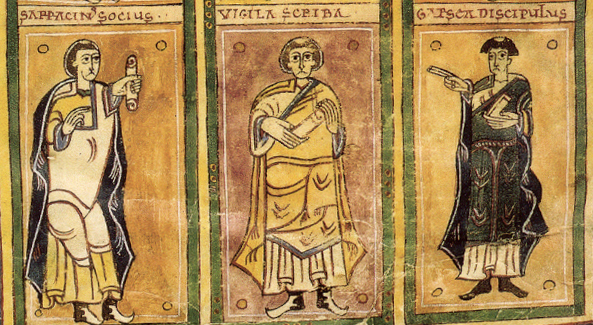Codex Vigilanus on:
[Wikipedia]
[Google]
[Amazon]
 The ''Codex Vigilanus'' or ''Codex Albeldensis'' (Spanish: ''Códice Vigilano'' or ''Albeldense'') is an
The ''Codex Vigilanus'' or ''Codex Albeldensis'' (Spanish: ''Códice Vigilano'' or ''Albeldense'') is an
Interlace Decoration and the Influence of the North on Mozarabic Illumination (in Notes).
''The Art Bulletin'', Vol. 42, No. 3. (September, 1960), pp 211–218. *Guilmain, Jacques.
Zoomorphic Decoration and the Problem of the Sources of Mozarabic Illumination.
''Speculum'', Vol. 35, No. 1. (January, 1960), pp 17–38. *Guilmain, Jacques.
The Forgotten Early Medieval Artist.
''Art Journal'', Vol. 25, No. 1. (Autumn, 1965), pp 33–42. *Bishko, Charles Julian.
Salvus of Albelda and Frontier Monasticism in Tenth-Century Navarre.
''Speculum'', Vol. 23, No. 4. (October, 1948), pp 559–590. 976 10th-century illuminated manuscripts Visigothic Kingdom Medieval history of the Basque Country Mozarabic art and architecture 10th century in Navarre 10th-century writers in Latin
 The ''Codex Vigilanus'' or ''Codex Albeldensis'' (Spanish: ''Códice Vigilano'' or ''Albeldense'') is an
The ''Codex Vigilanus'' or ''Codex Albeldensis'' (Spanish: ''Códice Vigilano'' or ''Albeldense'') is an illuminated
Illuminated may refer to:
* Illuminated (song), "Illuminated" (song), by Hurts
* Illuminated Film Company, a British animation house
* ''Illuminated'', alternative title of Black Sheep (Nat & Alex Wolff album)
* Illuminated manuscript
See also
compilation of various historical documents accounting for a period extending from antiquity to the 10th century in Hispania
Hispania was the Ancient Rome, Roman name for the Iberian Peninsula. Under the Roman Republic, Hispania was divided into two Roman province, provinces: Hispania Citerior and Hispania Ulterior. During the Principate, Hispania Ulterior was divide ...
. Among the many texts brought together by the compilers are the canons of the Visigothic Councils of Toledo, the '' Liber Iudiciorum'', the decrees of some early popes and other patristic writings, historical narratives (such as the ''Crónica Albeldense'' and the '' Life of Mohammed''), various other pieces of civil and canon law
Canon law (from , , a 'straight measuring rod, ruler') is a set of ordinances and regulations made by ecclesiastical jurisdiction, ecclesiastical authority (church leadership) for the government of a Christian organization or church and its membe ...
, and a calendar. It is now in the library of El Escorial monastery, with the shelfmark D.I.2.
The compilers were three monks of the Riojan monastery of San Martín de Albelda: Vigila, after whom it was named and who was the illustrator; Serracino, his friend; and García, his disciple. The first compilation was finished in 881, but was updated up to 976. The original manuscript is preserved in the library of El Escorial (as Escorialensis d I 2). At the time of its compilation, Albelda was the cultural and intellectual centre of the Kingdom of Pamplona. The manuscripts celebrate with illustrations not only the ancient Gothic kings who had reformed the law — Chindasuinth, Reccesuinth, and Ergica — but also its contemporary dedicatees, the rulers of Navarre: Sancho II of Pamplona and his queen, Urraca, and his brother Ramiro Garcés, King of Viguera.
The codex contains, among other pieces of useful information, among the earliest mention and representation of Arabic numerals
The ten Arabic numerals (0, 1, 2, 3, 4, 5, 6, 7, 8, and 9) are the most commonly used symbols for writing numbers. The term often also implies a positional notation number with a decimal base, in particular when contrasted with Roman numera ...
in the West. They were introduced by the Arabs
Arabs (, , ; , , ) are an ethnic group mainly inhabiting the Arab world in West Asia and North Africa. A significant Arab diaspora is present in various parts of the world.
Arabs have been in the Fertile Crescent for thousands of yea ...
into Spain around the early 8th century.
The illuminations are stylistically unique, combining Visigothic
The Visigoths (; ) were a Germanic people united under the rule of a king and living within the Roman Empire during late antiquity. The Visigoths first appeared in the Balkans, as a Roman-allied barbarian military group united under the comman ...
, Mozarabic, and Carolingian elements. The interlace patterns and the drapery show Carolingian, as well Italo-Byzantine, influence. The use of animals as decoration and for supporting columns also parallels contemporary Frankish usage. More Carolingian and less Byzantine influence is evident in the '' Codex Aemilianensis'', a copy of the ''Vigilanus'' made at San Millán de la Cogolla in 992 by a different illustrator.Guilmain, "Forgotten," 36–37.
Notes
Sources
{{commons category, Codex Vigilanus *Guilmain, Jacques.Interlace Decoration and the Influence of the North on Mozarabic Illumination (in Notes).
''The Art Bulletin'', Vol. 42, No. 3. (September, 1960), pp 211–218. *Guilmain, Jacques.
Zoomorphic Decoration and the Problem of the Sources of Mozarabic Illumination.
''Speculum'', Vol. 35, No. 1. (January, 1960), pp 17–38. *Guilmain, Jacques.
The Forgotten Early Medieval Artist.
''Art Journal'', Vol. 25, No. 1. (Autumn, 1965), pp 33–42. *Bishko, Charles Julian.
Salvus of Albelda and Frontier Monasticism in Tenth-Century Navarre.
''Speculum'', Vol. 23, No. 4. (October, 1948), pp 559–590. 976 10th-century illuminated manuscripts Visigothic Kingdom Medieval history of the Basque Country Mozarabic art and architecture 10th century in Navarre 10th-century writers in Latin